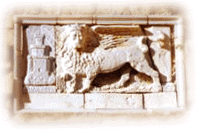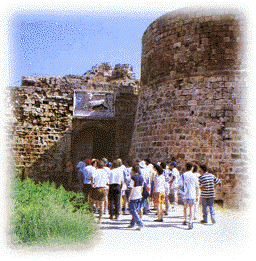|
|
 Othello's tower
is the medieval fortress or citadel guarding both the harbour and the town of Famagusta.
This is referred to in one of Shakespeare's plays in which Othello is described as a Moor.
This is not so; it is the name of a Venetian governor of 1506. However, Shakespeare knew
little about Cyprus and had never been there. The entrance to the tower is shown in the
picture and is pierced through the Venetian fortifications which date from between 1500
and 1550. Othello's tower
is the medieval fortress or citadel guarding both the harbour and the town of Famagusta.
This is referred to in one of Shakespeare's plays in which Othello is described as a Moor.
This is not so; it is the name of a Venetian governor of 1506. However, Shakespeare knew
little about Cyprus and had never been there. The entrance to the tower is shown in the
picture and is pierced through the Venetian fortifications which date from between 1500
and 1550.
Above the gateway is a marble slab on which
sculptured the badge of Venice, a winged lion, so frequently seen in other parts of Cyprus
such as in Kyrenia Castle, Nicosia, and Bellapais Abbey. Inscription on the marble reads
`Nicolo Foscarini, the Venetian Captain', together with the Venetian lion of St. Mark.
 An aerial view would show the shell of the medieval castle inside the Venetian Walls and
an imaginary sketch of this is shown here. As a result of the inventions of gunpowder and
cannon, the Venetians altered the castles in order to suit the needs of their artillery.
Usually they did not destroy the old walls, they were far too thick, but the old square
towers were replaced with round ones.
An aerial view would show the shell of the medieval castle inside the Venetian Walls and
an imaginary sketch of this is shown here. As a result of the inventions of gunpowder and
cannon, the Venetians altered the castles in order to suit the needs of their artillery.
Usually they did not destroy the old walls, they were far too thick, but the old square
towers were replaced with round ones.
It should be obvious that a rectangular tower could easily have its corners knocked
off by gunfire. Wherever the old walls were preserved, they were pierced by
gunports. On
entering the courtyard of the citadel there are some interesting old cannon lying on the
ground. One of them is made of bronze and is in excellent condition after being out in the
wind and rain for 400 years. It is Spanish, and this kind of alloy metal was much favoured
by the Spaniards in their great galleons. Cannon were fired by a red hot poker inserted
into a hole at one end, but sometimes, owing to faulty methods of casting, guns exploded
and then there was a nasty accident. The Turkish cannon had iron rings along the muzzle
and can be seen in the courtyard. There are some cannon balls lying about and most are of
cast iron.
Inside the Walls is the Great Hall,
and with the large kitchen at one end, it is presumed that this was the refectory or
dining hall. It dates from about 1300 and is massively constructed with a vaulted roof
supported by tall Gothic arches. Windows were usually very small for defence purposes and
no glass was used, pieces of cloth or carpets kept out wind and rain. However, in those
times it could be a quite comfortable place with fine tapestries on the wall and huge
fires blazing away at one end, where the whole carcass of a moufflon could be roasted. Not
faroutside the town there is vast interior plain of Cyprus known as the Mesarya and here
the nobles were hunting.
Steps lead up to the embattlements where there is a fine view of both ancient and modern
harbours. Modern ships still use the same harbour entrance as it was in the golden age of
Famagusta, 1300 to 1400 A.D. In those times harbours were defended by a huge iron chain
slung across the water, and just by the entrance, and the opposite the Citadel, can be
seen a clump of rocks on a promontory where there was the chain tower. The chain was
lowered into the water when enemy ships were in the offing. The other harbour in Northern
Cyprus, Kyrenia, was also defended by chain and there the chain tower still stands in the
middle of the harbour.
|









